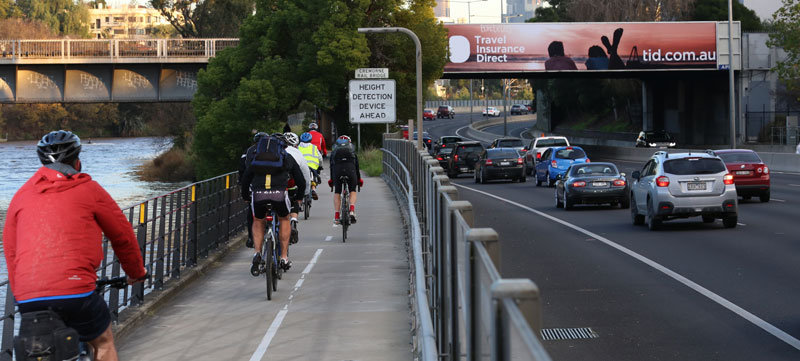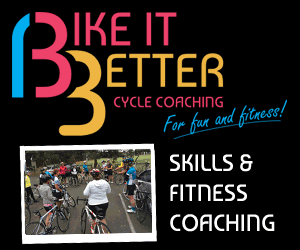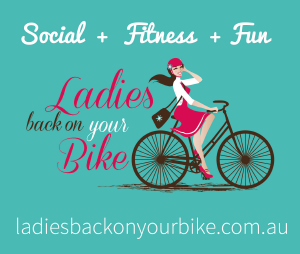Riding to work is a great way to get active, save money and put some extra time up your sleeve, finds Margot McGovern.

Many thousands of Australians ride to work every day. I’m one of them. Even when it’s cold I’m brave enough to weather the storms for my rush of endorphins in the morning, to saddle up and focus on the road ahead.
I’m one of a growing number of people are shirking the crawling queues of peak hour traffic saving money on petrol and parking and taking two wheels instead.
As well as saving money (and not having my nose smooshed into someone’s armpit on an overcrowded bus or tram) I’m also getting my recommended physical activity for the day—and all while I’m travelling to work!
Census figures show that the number of people riding to work is on the rise, with 103,913 Australians riding to work in 2011, up from 78,210 in 2001. On National Ride2Work Day in October last year more than 150,000 Australians took part—many for the first time—dusting off their bikes for their first, two-wheeled commute.
If you, like me, live within 15km of your workplace, getting there by bike is the smart choice. If you live too far to ride the whole way, jumping on your bike instead of driving to the train station is a great way to get your daily dose of fresh air and exercise.
For those who haven’t commuted by bike before, National Ride2Work Day is the perfect time to start. (In 2015, National Ride2Work Day is on Wednesday, 14 October, and you can find out more and register your ride at www.ride2work.com.au.)
Getting started
Leyla Asadi began riding to work one month ago. She was looking to save money and sick of commuting on stuffy, overcrowded trams, but she wasn’t a rider and the idea of cycling on the road made her anxious. Her first step was to buy a bike. She chose a ladies’ vintage-style bike from Samson Cycles, and picked up a helmet, lights, lock and pump while she was there. She chose Samson Cycles in part because it’s close by her house, which will come in handy if she has any maintenance issues and when her bike needs a service.
If riding to work was going to become a regular part of her routine, Leyla wanted the transition to be as easy as possible. “If I didn’t have to change my clothes or my handbag, then that was one less barrier,” she explained. “I’m not a fan of dressing up in cycling gear—I started cycling in skirts and heels.”
Asadi’s commute is 6km from North Fitzroy to Melbourne’s CBD. “My main concern was which roads to take,” she said. “I found the Ride the City website really helpful because it gives you different options depending on if you want the most direct route, or one with less traffic.” Once she’d mapped out which way to go, she did a test ride on the weekend.
With her preparation in hand, Asadi headed off on her first daily commute—though she admitted that her first ride in peak hour was nerve-wracking. “The traffic was heavy for all kinds of vehicles,” she said. “It was a little bit scary dealing with other road users.” She was also worried about being too slow or causing an accident. “I honestly thought I would I would scrape something or bump into someone, but it was fine.” In fact, as well as being cheaper and giving her exercise, she discovered another surprising benefit; “it was quicker… Commuting to work is easier than most people think.”
Now that her initial nerves have subsided, Asadi is enjoying her commute free from the concerns she once had. “You’re free and out in the air,” she said. “It’s really good if your job is building-based.” Even starting in winter didn’t prove an issue: “I thought the weather would be much worse. But I hardly bring a coat anymore.”
“[I love] the independence,” Asadi said.
“I’m in control of getting to my destination.” What’s more, Asadi isn’t just riding to work anymore. “I’m now using the bike in other parts of my life. I’ve started riding to uni, and sometimes I stop in at the shops on my way home from work,” she said.
So what advice does she have for someone considering riding to work for the first time? “Check out the best route that takes you off a main road to start with—find an easier path so you feel comfortable.” She believes confidence is also the key.
“Don’t be intimidated. Don’t feel like you’re being too slow… Make sure you feel you have as much right to the road as anyone else.”
Asadi also said that for new riders, like herself, having a geared bike makes it much easier. She’s also a Bicycle Network member and recommends all riders get insurance “for peace of mind.”
New commuter FAQs
If you are (or someone you know is) keen to start commuting by bike, but still have some concerns, these answers to the top 10 most frequently asked questions from aspiring commuters may provide the assurance you need. You can also get a copy of Bicycle Network’s Start Riding Pack for hints and tips
1. Am I fit enough?
You’ll be surprised how far you can ride. If you initially can’t manage the full trip, catch the train part way and gradually increase the distance as your strength builds. Once you start riding regularly, your fitness and overall health will quickly improve.
2. What equipment do I need?
Aside from a bike, you’ll need a well-fitted helmet and a lock—preferably a D-lock. If you’re riding in dark or low-light conditions, you’re legally required to run a white front and red rear light, visible at a minimum 200m. If you need help selecting the right lock or lights, check out the results from the Ride On locks test and lights test.
Get your local bike shop to check you bike’s size and saddle height. If your bike has been living in the shed for a while, book it in for a service.
3. How do I carry my gear?
Backpacks or courier bags are adequate for small loads, while pannier bags fastened to a rear rack are ideal for bulkier cargo. Where possible, opt for waterproof options.
4. Do I have time?
If you live within 15km of your workplace, riding is likely faster than other modes of transport during peak periods. For longer journeys, consider saving time by riding partway then catching the train. By making your commute a workout, you’ll also save time you might otherwise have spent at the gym.
5. What should I wear?
Quick-drying, lightweight clothing that allows for freedom of movement is ideal. Check to see what end of trip facilities, such as lockers and showers, your workplace provides. If yours is a short, relaxed commute you may be able to ride in your work clothes.
6. How do I plan my trip?
Use online mapping tools, talk to other riders in your area or contact your state/territory bike organisation for a map showing the most bike friendly routes. When planning your route, opt for off-road paths and quiet back streets, or roads with good bike infrastructure and a high volume of riders. Do a trial ride on the weekend, and consider recruiting a friend or colleague to ride with you. You can also check out Bicycle Network’s links to maps and resources.
7. Do I live too far away?
Partway is OK. Ride to your local train station, or take your bike on the train and get off early to ride part of the distance. If you live in Victoria, consider signing up for Parkiteer, which offers free, secure bike parking at train stations.
8. What if it rains?
Don a soft-shell rain jacket (preferably with zippered vents for breathability) and water proof pants or overpants. Pack a change of clothes and any valuables in a waterproof bag. Ride with extra caution and begin braking early as rain can make the roads slippery. For more info, see Ride On’s guide to wet weather riding.
9. What about riding in traffic?
Riding in traffic can be daunting, but isn’t a problem providing you exercise the three Cs:
- Common sense
Abide by the road rules, behave in a predictable manner and make your intentions clear by using hand signals.
- Courtesy
Make eye contact with other riders and motorists to confirm they’ve seen you. Be assertive, without being aggressive.
- Caution
Be aware of your surroundings and other road users. Look out for obstacles, such as opening car doors.
10. What if I get a puncture?
Learn how to fix a flat before you get rolling and carry a puncture repair kit when you ride. If you’re not sure how to change a tube, see the Ride On step-by-step guide. Carry a mobile phone and know where the nearest bike shops are along your route in case you get caught out without the right tools.
For more information on Ride2Work Day and the ongoing Ride2Work program, visit www.ride2work.com.au.
Know someone who’s keen to ride but isn’t rolling yet? Sign them up for a free Start Riding Pack www.startriding.com.au.
Ride On content is editorially independent, but is supported financially by members of Bicycle Network. If you enjoy our articles and want to support the future publication of high-quality content, please consider helping out by becoming a member.



I ride 34km to work and the same home. I live in the outer eastern suburbs and the hills make for a great heart starter first thing in the morning. I don’t mind rising at 5am because I am now very fit and alert. I love to ride and am taking on more events this year. It’s good to be alive!
I would like to see more bike lanes on many of the main roads, particularly in the southern suburbs. I am deterred from riding places as the most direct routes are 80km/h and that gets scary at times with cars that don’t respect bikes and give them space. We need to make people feel safer on a bike if we expect more to mount up and us it as a mode of transport.
I have managed to overcome the sweaty and hilly 22km commute from my house to work by getting an ebike – best thing I’ve ever done. Gives you a push off at the lights, assistance walking up the stairs and negates the effect of a headwind or steep hill. And you still get the exercise benefits of normal cycling!
Totally agree on the ebike. I have a Gazelle mid-drive ebike and I manage my 15km each way commute in Brisbane in my work clothes (office job). 45 minutes each way, no fuss. Hop on and ride, then chain up and walk up to my desk. No mucking around with changes of clothes, showers etc. Just like a brisk walk to work.
It’s an investment. My bike retails for $4000. But it comes with everything – mud guards, chain guard, integrated lights, rear rack, wheel lock. Get yourself a pannier bag and you’re done.
Just love my daily commute to work on my deadly treadly at ‘go-granny-go’ pace. Love seeing the seasonal changes and keeps me fit and mobile.
Two years ago I didn’t ride, and was 108Kg.
I now ride everyday (27km each way) and am 80Kg. I started riding once a week, then twice, then…. well, you get the picture.
Riding with commuter mates keeps you honest (you can’t skip a ride without a decent excuse).
What makes it good is that it’s more predictable than driving / public transport. Sure it might take 60 minutes to get to work, rather than 45, but I’m never held up in traffic, or at the mercy of Metro cancellations.
4 years ago I was 64kg. Now I ride every day and now weigh 69kg. The way i’m going I’ll hit 80kg before I retire but at least I don’t need to drive